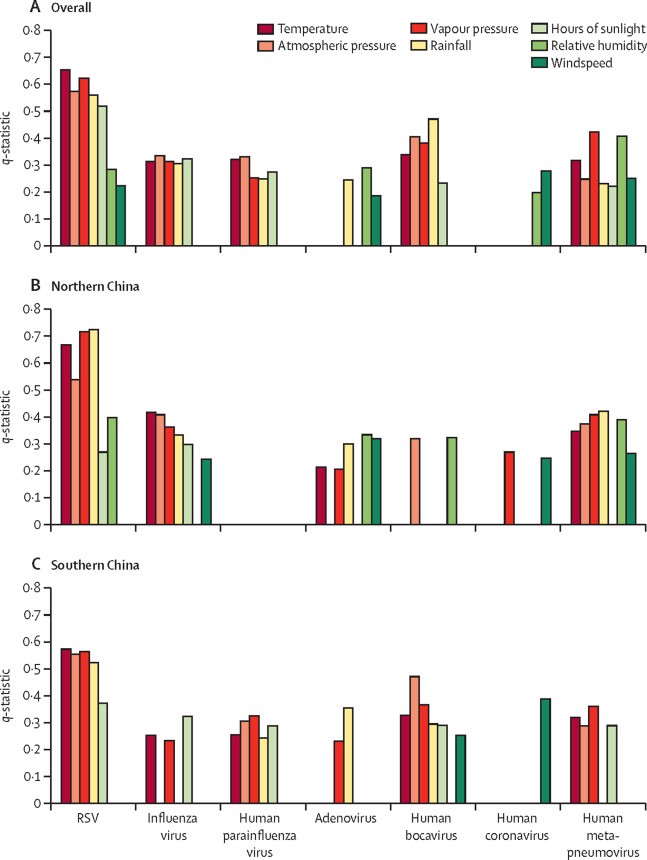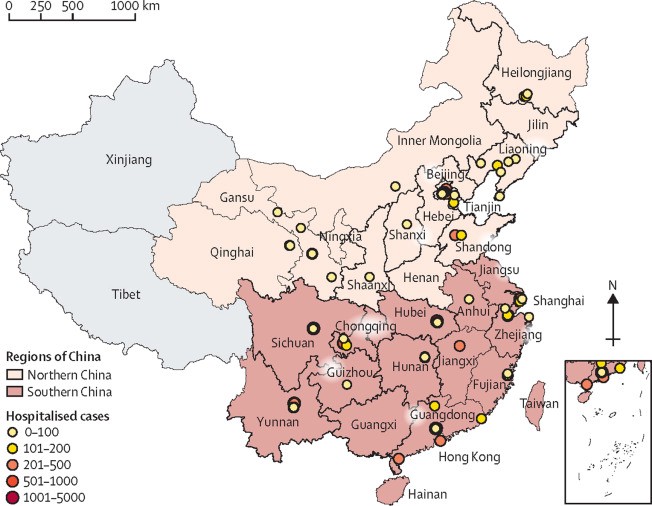Background
Acute lower respiratory infections (ALRIs) caused by respiratory viruses are common and persistent infectious diseases worldwide and in China, which have pronounced seasonal patterns. Meteorological factors have important roles in the seasonality of some major viruses, especially respiratory syncytial virus (RSV) and influenza virus. Our aim was to identify the dominant meteorological factors and to model their effects on common respiratory viruses in different regions of China.
Methods
We analysed monthly virus data on patients hospitalised with ALRI from 81 sentinel hospitals in 22 provinces in mainland China from Jan 1, 2009, to Sept 30, 2013. We considered seven common respiratory viruses: RSV, influenza virus, human parainfluenza virus, adenovirus, human metapneumovirus, human bocavirus, and human coronavirus. Meteorological data of the same period were used to analyse relationships between virus seasonality and seven meteorological factors according to region (southern vs northern China). The geographical detector method was used to quantify the explanatory power of each meteorological factor, individually and interacting in pairs, on the respiratory viruses.
Findings
28 369 hospitalised patients with ALRI were tested, 10 387 (36·6%) of whom were positive for at least one virus, including RSV (4091 [32·0%] patients), influenza virus (2665 [20·8%]), human parainfluenza virus (2185 [17·1%]), adenovirus (1478 [11·6%]), human bocavirus (1120 [8·8%]), human coronavirus (637 [5·0%]), and human metapneumovirus (615 [4·8%]). RSV and influenza virus had annual peaks in the north and biannual peaks in the south. Human parainfluenza virus and human bocavirus had higher positive rates in the spring–summer months. Human metapneumovirus had an annual peak in winter–spring, especially in the north. Adenovirus and human coronavirus exhibited no clear annual seasonality. Temperature, atmospheric pressure, vapour pressure, and rainfall had most explanatory power on most respiratory viruses in each region. Relative humidity was only dominant in the north, but had no significant explanatory power for most viruses in the south. Hours of sunlight had significant explanatory power for RSV and influenza virus in the north, and for most viruses in the south. Wind speed was the only factor with significant explanatory power for human coronavirus in the south. For all viruses, interactions between any two of the paired factors resulted in enhanced explanatory power, either bivariately or non-linearly.
Interpretation
Spatiotemporal heterogeneity was detected for most viruses in this study, and interactions between pairs of meteorological factors were found to enhance their influence on virus variation. These findings might be helpful to guide government planning, such as public health interventions, infection control practice, and timing of passive immunoprophylaxis, and might facilitate the development of future vaccine strategies.
Funding
National Natural Science Foundation of China, the Ministry of Science and Technology of China, and the Technology Major Project of China.
Translation
For the Chinese translation of the abstract see Supplementary Materials section.




